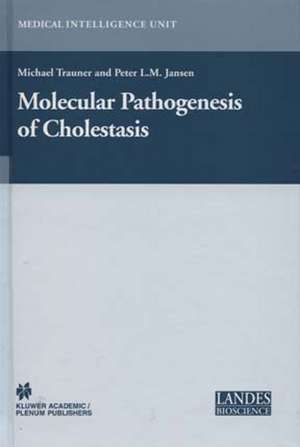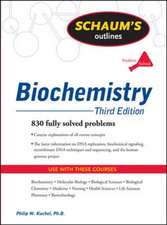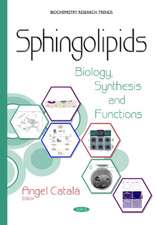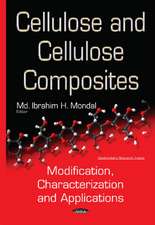Molecular Pathogenesis of Cholestasis: Medical Intelligence Unit
Editat de Michael Trauner, Peter L. M. Jansenen Limba Engleză Paperback – 23 oct 2012
Din seria Medical Intelligence Unit
- 5%
 Preț: 367.28 lei
Preț: 367.28 lei - 5%
 Preț: 367.64 lei
Preț: 367.64 lei - 18%
 Preț: 945.79 lei
Preț: 945.79 lei -
 Preț: 392.37 lei
Preț: 392.37 lei - 15%
 Preț: 630.88 lei
Preț: 630.88 lei - 5%
 Preț: 1090.97 lei
Preț: 1090.97 lei - 5%
 Preț: 715.19 lei
Preț: 715.19 lei - 5%
 Preț: 1100.30 lei
Preț: 1100.30 lei - 5%
 Preț: 367.84 lei
Preț: 367.84 lei - 5%
 Preț: 981.72 lei
Preț: 981.72 lei - 5%
 Preț: 1424.31 lei
Preț: 1424.31 lei - 20%
 Preț: 559.21 lei
Preț: 559.21 lei - 5%
 Preț: 1094.97 lei
Preț: 1094.97 lei - 5%
 Preț: 783.04 lei
Preț: 783.04 lei - 18%
 Preț: 942.31 lei
Preț: 942.31 lei - 5%
 Preț: 367.28 lei
Preț: 367.28 lei - 5%
 Preț: 1098.48 lei
Preț: 1098.48 lei - 5%
 Preț: 366.70 lei
Preț: 366.70 lei - 5%
 Preț: 1095.73 lei
Preț: 1095.73 lei - 5%
 Preț: 368.73 lei
Preț: 368.73 lei - 5%
 Preț: 1092.99 lei
Preț: 1092.99 lei - 5%
 Preț: 1093.88 lei
Preț: 1093.88 lei - 5%
 Preț: 1086.58 lei
Preț: 1086.58 lei - 5%
 Preț: 1417.75 lei
Preț: 1417.75 lei - 5%
 Preț: 362.88 lei
Preț: 362.88 lei - 5%
 Preț: 980.68 lei
Preț: 980.68 lei - 5%
 Preț: 715.35 lei
Preț: 715.35 lei - 5%
 Preț: 1092.79 lei
Preț: 1092.79 lei - 5%
 Preț: 365.61 lei
Preț: 365.61 lei - 5%
 Preț: 715.00 lei
Preț: 715.00 lei - 5%
 Preț: 364.53 lei
Preț: 364.53 lei - 5%
 Preț: 1097.18 lei
Preț: 1097.18 lei - 5%
 Preț: 708.58 lei
Preț: 708.58 lei - 5%
 Preț: 1095.54 lei
Preț: 1095.54 lei - 5%
 Preț: 716.28 lei
Preț: 716.28 lei - 15%
 Preț: 644.49 lei
Preț: 644.49 lei - 5%
 Preț: 714.46 lei
Preț: 714.46 lei - 5%
 Preț: 1478.11 lei
Preț: 1478.11 lei - 18%
 Preț: 943.88 lei
Preț: 943.88 lei - 5%
 Preț: 1096.81 lei
Preț: 1096.81 lei
Preț: 384.07 lei
Nou
Puncte Express: 576
Preț estimativ în valută:
73.50€ • 76.45$ • 60.68£
73.50€ • 76.45$ • 60.68£
Carte tipărită la comandă
Livrare economică 10-16 aprilie
Preluare comenzi: 021 569.72.76
Specificații
ISBN-13: 9781461347675
ISBN-10: 146134767X
Pagini: 384
Ilustrații: XIII, 366 p.
Dimensiuni: 165 x 248 x 20 mm
Ediția:Softcover reprint of the original 1st ed. 2004
Editura: Springer Us
Colecția Springer
Seria Medical Intelligence Unit
Locul publicării:New York, NY, United States
ISBN-10: 146134767X
Pagini: 384
Ilustrații: XIII, 366 p.
Dimensiuni: 165 x 248 x 20 mm
Ediția:Softcover reprint of the original 1st ed. 2004
Editura: Springer Us
Colecția Springer
Seria Medical Intelligence Unit
Locul publicării:New York, NY, United States
Public țintă
ResearchCuprins
1. Mechanisms of Bile Formation: An Introduction.- 2. Hepatocellular Transport Systems: Basolateral Membrane.- 3. The ABC of Canalicular Transport.- 4. Gap Junctions in the Liver.- 5. Cholestasis• An Intracellular “Traffic Jam”.- 6. The Pathobiology of Cholangiocytes.- 7. Genetics, Mutations, and Polymorphisms.- 8. Transcriptional Regulation of Hepatobiliary Transporters.- 9. Signal Transduction in Bile Formation and Cholestasis.- 10. Bile Acid-Mediated Apoptosis in Cholestasis.- 11. Hepatic Drug Metabolism.- 12. Pathology of Cholestasis.- 13. Disorders of Bile Acid Transport.- 14. Genetic Defects in Biliary Lipid Transport.- 15. Transport of Bilirubin Conjugates across Hepatocellular Membrane Domains and the Conjugated Hyperbilirubinemia of Dubin-Johnson Syndrome.- 16. Hepatic Copper Transport.- 17. Molecular Basis of Primary Biliary Cirrhosis.- 18. Primary Sclerosing Cholangitis.- 19. Drug-Induced Cholestatic Liver Disease.- 20. Acquired Alterations of Transporter Expression and Function in Cholestasis.- 21. Pathophysiological Basis of Pruritus and Fatigue in Cholestasis.- 22. Bone Disease in Chronic Cholestatic Liver Disease.- 23. Fat Absorption and Lipid Metabolism in Cholestasis.- 24. Medical Therapy of Cholestatic Liver Diseases.- 25. Hepatocyte Transplantation and Liver-Directed Gene Therapy.












